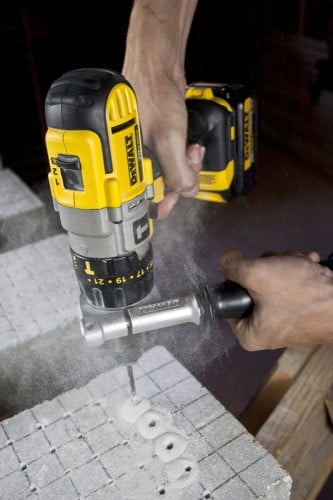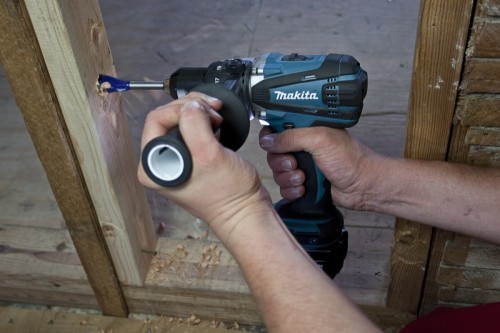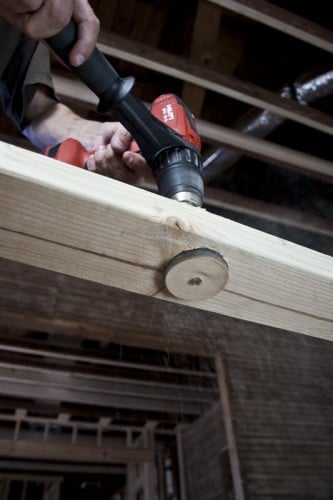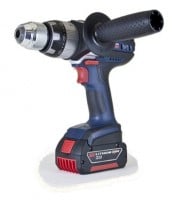For me, the cordless hammer drill is arguably one of the most well-used tools in my arsenal. Anyone who uses these tools knows they have tons of torque, and the selectable transmission gears, variable speed motors and various drilling modes make them extremely versatile. In fact, you can drill and/or drive fasteners into nearly any material with these tools. No matter how advanced rotary hammer technology gets or how impressive the new wave of cordless impact drivers may be, cordless hammer drills are still the go-to tool for many builders and contractors. When drilling into wood, they give you a more consistent cut with paddle bits and hole saws, and they won’t stall out as easily as an impact driver will when they run into obstructions.
Editor’s Note: Check out our 2015 Best Heavy Duty 18V Hammer Drill Buying Guide
The multi-purpose aspect of the hammer drill has got to be its largest appeal. With the multi-geared transmissions, I have been known to set my drill in low gear to mix up a bucket of tile grout or a batch of knock-down drywall finish. Given the rise of concrete construction in the residential market, we are seeing more and more the need to drill a hole or two in concrete to set an anchor. For this type of “occasional” drilling of smaller diameter holes for anchors and other concrete fasteners, the cordless hammer drill is perfect. Because of the tremendous use you can get out of these tools, it’s very likely the hammer drill is going to be around for a long while. Plus, as manufacturers continue to develop and improve on their models to make them smaller, more powerful and versatile, the reasons for wanting to see which ones are the market leaders becomes clear. This round-up is going to take a first hand look at most of the major players in the 18V cordless hammer drill segment.
How a Hammer Drill Works
Hammer drills use a “cam-action” to create their hammering motion. Inside the gear case, there are two sets of toothed gears that mechanically interact with each other. When the motor is rotating, this mechanism causes the chuck assembly and bit to move forward and backward on the rotational axis of the motor. In fact, the hammer action is directly tied to the rotation of the motor. The faster the motor spins, the more “hits” occur. Given the design of the hammer system, these types of drills are normally not used for production (serial) drilling but rather for occasional masonry drilling applications.
The 18V Cordless Hammer Drill Round-up Tools
Since this is a test of18V cordless hammer drills, it’s worth pointing out some of the commonalities among all the tools in the lineup. At the time when I requested the tools for this review, the products submitted represented the top offerings from each manufacturer for this category. All the tools were tested as they come in their kit forms, which is to say that I didn’t swap in higher capacity batteries to enhance performance. Each drill kit came with two batteries, a charger, detachable side handle and some kind of carry case or tool bag. If you are a carry case kind of guy, the DeWalt is the most compact and the carry-on sized Makita is the largest. All the drills have switchable, multi-gear transmissions, variable speed motors, torque limiting selection rings and three different drilling/driving modes. All the drills have keyless chucks that are ratcheting, single sleeve models with serrated jaws that bite into the bits to minimize slippage (especially when in hammer mode). The drills that we tested featured three different motor design characteristics—among them, brushless, brushed, frameless and four pole varieties. In my testing I strove to see if any of these motor technologies helped to make a drastic difference in performance and if that could be quantified.
Testing 18V Cordless Hammer Drills
When looking at hammer drills and how to test them, I tried to come up with ways that would simulate how I have used them on past construction projects. For starters, my testing was not designed to see which drill I could cause to smoke first by doing drilling and fastening applications that they weren’t designed to do. Mixing up buckets of thinset or mortar is a good example of what not to do with a cordless drill. (From experience, I can say that you can get a way with this a few times, but eventually you will burn up even the most expensive and powerful drill.) In contrast, I wanted to test using applications and materials that would be encountered by any regular Joe involved in residential or commercial construction.
Test 1 – Concrete Endurance
With freshly charged batteries on each drill and a brand new 3/16” Tapcon brand carbide tipped concrete drill bit in the chuck, I was ready for the first test. The goal of this test was to see how many 2” deep holes (for use with 1/4” x 1-3/4” Tapcon screws) we could drill on a single charge. After every 20 holes we gave each hammer drill a minimum of a 15 minute cool down time to reduce overheating the tools and the batteries. Using 4” x 8” x 16” masonry cap blocks we picked up from Lowe’s, I drew a 1” x 1” grid on each. Three different contractors were used to test each tool to help minimize the differences in user technique and to provide feedback as to how each tool functioned. The winner for this test was the Milwaukee 2604-22 with second place going to the Hilti SFH18-A. The interesting thing to note on both of these tools is that they are the only drills in the test that came with batteries over 3.0 amp-hours. In debriefing, we saw that the number of holes seemed directly related to the watt-hour rating of the batteries. In fact, if these two drills were equipped with lower capacity batteries they would likely have been right in the middle of the pack as far as the number of holes drilled. Given that the Ridgid R8611501 currently comes with a 3.0 amp-hour battery, it did a stellar job for being the only other tool to break 100 holes. Considering many manufacturers (including Ridgid) are in the process of bringing their next-gen 4.0 amp-hour batteries to market, this should present an exciting upgrade for current users of these drills.
Nearly 600 holes were drilled in all, and we had an opportunity for some secondary results that had to do with user comfort. Since we had multiple tradesmen involved in testing these tools, I had a good chance to gain some feedback on the perceived vibration and ergonomics of each. I say “perceived” vibration since I lacked scientific tools to actually measure it. (Such tools exist but were out of the scope of this review.) The tools with the least amount of felt user vibration were the Hilti, Makita and Milwaukee (in that order), making them a real joy to operate. When using these drills, it felt as if the bit was simply melting into the concrete. The drill that just about made all our teeth chatter and our hands fall asleep was the Hitachi. Limiting user fatigue didn’t seem to be a design priority in this drill’s development.
Test 2 – Speed in Concrete
The objective of this test was to show off how fast each hammer drill could make a hole. What this test demonstrates is the tool’s ability to effectively transmit the energy of the drilling and hammering action into the workpiece. Specifically, I measured and averaged how fast our construction professionals could drill a hole in the same concrete cap blocks used in Test 1. With new batteries installed in each drill and a brand new 3/16” Tapcon brand carbide tipped concrete drill bit in each chuck, I had each of my contractors drill four holes. Each hole was drilled to a depth of two inches, and the time to drill each hole was recorded. In total, twelve holes were drilled by each tool and the average time of drilling these holes was taken in order to get the time seen in the chart. Since three different operators were enlisted to test each tool, we also minimized the effects of differences in drilling technique.
Timed Drilling Tests
On serial drilling applications, we’ve found rotary hammers to be the the tool of choice, but that’s not always the tool you have on-hand for less repetitive work. In any case, we wanted to see how quickly each of our seven hammer drills could bore a 3/16″ Tapcon bit two inches into our 4″ cap block.
There are three solid ranges of speed that came out of this test, The fastest tools were the Milwaukee, Hilti and the Makita (in that order)—all taking less than five seconds. The second place group included Bosch, DeWalt and Ridgid—each hitting around the mid-five seconds. The slowest tool in the test was the Hitachi which averaged over a second longer than the next closest tool.
Test 3 – Wood Boring
For most of my plumbing and electrical rough-in projects I like to use self feeding bits. While traditional paddle bits are good, self feeding fluted bits are better. Chip removal is improved, and the need to bare down on the tool is almost eliminated since the bit will literally pull its way though the material. The trick with self feed bits is that when they are being fed into the material, you need a drill that can handle the task. For this test I took 1” Irwin Speedbor MAX Speed Bits and sent them through 2×4 spruce studs. All the drills were set to drill mode with the mechanical gear boxes set to the lowest speed which gives more torque. I timed each hole that I did and took the average to come up with the numbers in the table. The fastest drill in this test was the DeWalt, taking just 4.1 seconds to make the hole. Second place went to Milwaukee who came in at 4.4 seconds. Even some of the “slowest” tools, the Ridgid and Hilti, took just 5.5 seconds each (which is really not slow at all).
Test 4 – Hole Saws
Arguably, one of the most strenuous tasks for a cordless drill is using a hole saw. Hole Saws need a lot of torque and power. For this test we used 2” Lenox hole saws and drilled three holes with each drill though a spruce 2×4. The average time was taken for each tool to get the number that is on the chart. The DeWalt was the clear winner in this test, and the Bosch came in a close second. The interesting thing that we noted is that the tools that did really well in the concrete drilling applications did not necessarily fare the same with high-torque drilling tests in wood. If you thought a hammer drill was a hammer drill, be sure to check out our chart near the end of the review. There is a 14.4 second difference between the fastest and slowest drill when tackling a single 2″ hole. That’s a stat that might just change your mind.
Test 5 – Lag Bolt Install
As a final test to challenge the torque, power and durability of these drills, I decided to drive large size lag screws into laminated board made up of seven layers of 3/4” sub-flooring plywood. Plywood is a great choice since it is not prone to cracking or checking. I chose 1/2″ x 6″ long lag screws as the size to base this test on. I did not do any pre-drilling or pilot holes, and I was not concerned with the number of screws that could be put in. Rather, I was simply looking to see if they could be driven fully home. The idea behind this ambitious test comes from dock and deck building where large size ledger lags are utilized. The only difference is that pre-drilling those holes is preferred and has actually been shown to provide a more secure hold.
The test results reveal that actually none of the tools were able to fully install the 1/2″ x 6″ lag screws. Not being able to fully install the screws is not a failure, but rather a demonstration of just how hard it is to drive these monster size screws. What I experienced with every drill was they they timed out when the load was more than the tool was able to handle. This is a good thing since the electronics kicked in to help protect the motor and battery from the potentially disastrous results of being over stressed. Every tool tested has this excellent feature. When I took my results and changed them into percentages of the screws that were installed, I found that it nearly perfectly corresponded with our initial electronic torque testing results as well as the manufacturer’s specs. My torque testing results vary slightly from the manufacturers’ since there are differences in equipment, fixtures and testing methods. My goal was not to prove or disprove manufacturers’ specifications, but rather to see if I could find a reasonable way to quantify the torque statements given by the manufacturers. I found that the tools with higher torque ratings were indeed able to drive the larger screws further before the tool experienced shut down. Score one for truth in advertising.
18V Cordless Hammer Drill Round-up Conclusion
Hammer Drills are a great demonstration that certain tools will never go out of style. The ability to drill wood or concrete and drive screws with the same tool makes 18V hammer drills the base tool for almost any decent tool kit on the market. In our round up, I really enjoyed the smooth way that Hilti SFH 18-A melted the drill bit into the concrete and how fast the DeWalt DCD985 sent a hole saw though a wood stud. I did not find substantial differences between the motor technologies other than the Milwaukee, which seemed to run faster and further than the rest. (Of course, some of that can be attributed to its higher capacity battery.) In many of the categories in which I tested the tools, you will see that most of the results are pretty close to each other. What this means is that aside from certain small features and user preferences, many of the tools in this line-up are very similar in terms of their raw performance.
18V Cordless Hammer Drill Round-up Tool By Tool
Bosch HDH181
The Bosch HDH181 hammer drill struck us as a wood-boring drill made to do occasion concrete drilling. Our conclusion is based on the fact that this drill did the fewest number of holes in our concrete endurance test, yet it did the second best in our wood drilling tests. We noted that when under extra strain, the handle assembly on the drill (not the secondary extension handle) seemed to flex a little too much. Also this drill is the second most expensive tool in the line-up.
Pros: Quick wood drilling.
Cons: Low concrete endurance, Unsettling tool handle flex, 1 year warranty.
Price: $329
Verdict: Decent wood drill with a bonus hammer function.
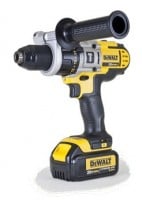
Of all the drills, the overall style and functionality of the DeWalt DCD985L2 stays true to its roots. Anyone that is familiar with earlier generations of this product will be quick to recognize that over the years not much has changed on the outside. With a large metal gear box, there is a certain level of conveyed toughness. I did like the three speed mechanical gear box. DeWalt seemed to take the “if its not broke, don’t fix it” path with this tool. This drill did the best in all our wood drilling tests and was mid pack for our concrete drilling. DeWalt just released new XR Series drills, however at present those are geared towards compactness and run-time (as opposed to raw torque), and so we didn’t include them in this series of tests.
Pros: Fastest wood drilling, Rock solid secondary handle, Three-speed gear box.
Cons: Rigid materials means extra felt vibration.
Price: $299
Verdict: Tough build quality that should deliver years of use.
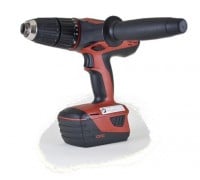
The single best word to describe the Hilti SFH 18-A is “refined”. With the overall fastest RPM and BPM, this drill literally melts the concrete out of its way. Much like an Italian sports car, the SFH 18-A has a unique sound all its own, and like an Italian sports car, it also has a premium price tag. Those who are familiar with Hilti products will be quick to latch onto this tool knowing that they are getting some serious performance wrapped up into a sleek package that is a joy to use.
Pros: Hi-speed, Low vibration, Second fastest concrete drilling speed, Lifetime warranty.
Cons: Expensive, No LED work light.
Price: $399
Verdict: The sports car of hammer drills that will make your buddies jealous.
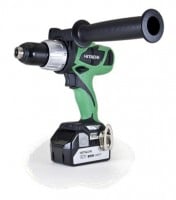
On paper the Hitachi DV18DBL looked promising. With a brushless motor and a four-level electronic speed control (besides the two speed switchable gear box), we thought that we would be in for a treat. Seeing how brushless motors seem to be the rage in some product categories, we were eager to see how this one did. I hate to say it, but we were disappointed. This drill not only did the fewest number of holes, but it was also the slowest in drilling concrete and had the most felt vibration. Perhaps for some users that demand extremely critical speed control, the presence of eight speed and torque settings will be enough. Hitachi also offers a limited lifetime warranty for their cordless lithium-ion tools.
Pros: Eight speed & torque options, Limited lifetime warranty, Belt clip.
Cons: Slow concrete drilling with too much felt vibration.
Price: $279
Verdict: User comfort, speed and torque need to be higher on the priority list next time around.
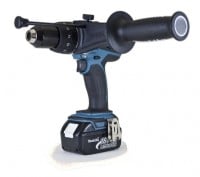
Makita had the highest measured torque of all the tools tested. That translated into competitive performance in our wood boring tests (though not the top spots) and netted the tool a tight third place in our concrete drilling speed tests. The Makita feels quick when drilling into concrete and felt vibration is pretty low. One ongoing pet peeve is that Makita still has no battery level meter on their packs or the tool, so you never know how much charge is left when you pick up the drill.
Pros: Belt clip, Highest measured torque, Low felt vibration.
Cons: No battery level gauge.
Price: $289
Verdict: A solid performer with a lot of competition.
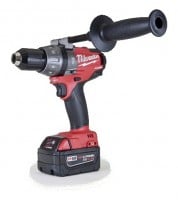
The engineers at Milwaukee have been doing their homework on what tool users like. With probably the best combination of size, performance and features, the 2604-22 is a great workhorse tool that keeps asking for more. The only thing that we did not like is that the detachable side handle is only able to be installed in two pre-set positions, leaving the user wanting more options to maximize comfort. Their 5-year warranty is also something that inspires confidence in your tool purchase.
Pros: Fastest in concrete with most holes drilled, 4.0 amp-hour battery, 5-year warranty.
Cons: Limited handle positioning.
Price: $299
Verdict: Concrete drilling monster.
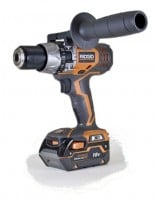
At my shop, Ridgid has become known for their workhorse dependability and features. They are not sexy or sleek tools, but they work. In today’s economy, price sometimes becomes a bigger factor than features for contractors. I am continually impressed with the quality and features that Ridgid incorporates into their tools for a a reasonable price. The R8611501K hammer drill is no exception. With what can be considered the best results for all the 3.0 amp-hour equipped tools in our concrete drilling, the Ridgid is a good choice and a solid performer.
Pros: Highest number of holes with a 3.0 amp-hour battery.
Cons: Middle of the pack torque numbers.
Price: $279
Verdict: Faithful and dependable workhorse.
Concrete bits and testing materials for this review were provided by Lowe’s Home Improvement Warehouse.


